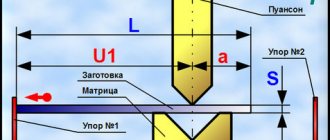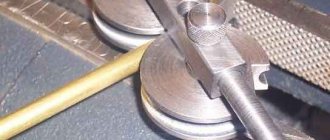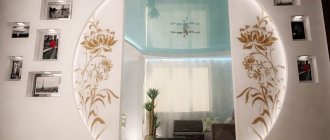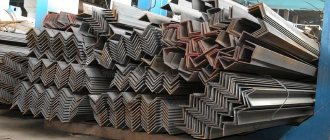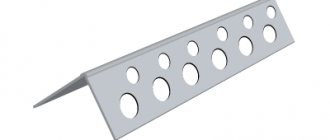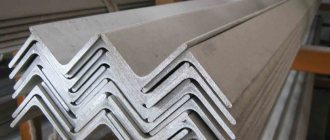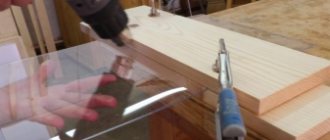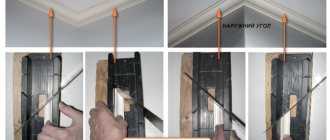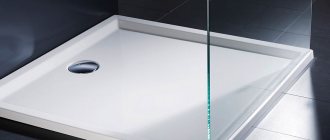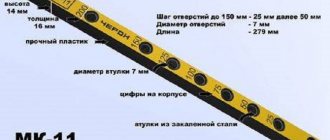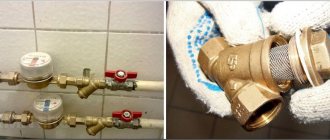Corner bending methods
Several basic methods are used to obtain structures of a given shape and profile from a metal corner, namely:
- cold bending,
- hot bending,
- shaping by cutting, bending and welding the finished product.
Cold bending of a metal corner, in turn, is divided into:
- free bending is when the corner is bent without the use of special equipment;
- bending using a rolling mechanism on a specialized profile bending machine.
The use of cold bending of a metal corner, unlike other methods, has certain advantages, namely:
- this is the least expensive method of giving metal a given shape, and does not require the use of additional equipment for heating, cutting, welding and subsequent processing of the metal;
- the resulting frame has greater strength, since it eliminates possible defects characteristic of heating, cutting and welding;
- finished structures are guaranteed to last longer due to the fact that the integrity of the metal profile structure is preserved during processing;
- the likelihood of metal corrosion occurring over time is reduced.
How to bend a metal corner 90 degrees – Home comfort – magazine
- Steel tees: what you need to know about the features The modern market offers two types of steel tees - flanged and straight. The last option is used when there is a need for docking with.
What you need to know about threaded connections? In order to provide separate zones of overpass structures for repair activities, threaded connections are used, which are currently represented by a wide variety.
Forged products: when quality and durability are unrivaled! Forged products have always been and remain in price. They are purchased by people with impeccable taste and good income. Forged fences, gates, wickets, .
Several basic methods are used to obtain structures of a given shape and profile from a metal corner, namely:
- cold bending,
- hot bending,
- shaping by cutting, bending and welding the finished product.
Cold bending of a metal corner, in turn, is divided into:
- free bending is when the corner is bent without the use of special equipment;
- bending using a rolling mechanism on a specialized profile bending machine.
The use of cold bending of a metal corner, unlike other methods, has certain advantages, namely:
- this is the least expensive method of giving metal a given shape, and does not require the use of additional equipment for heating, cutting, welding and subsequent processing of the metal;
- the resulting frame has greater strength, since it eliminates possible defects characteristic of heating, cutting and welding;
- finished structures are guaranteed to last longer due to the fact that the integrity of the metal profile structure is preserved during processing;
- the likelihood of metal corrosion occurring over time is reduced.
Necessary tool
The plastic corner for the interior arch must be properly secured. For this purpose, a list of such tools is prepared in advance:
- Plastic element to match the style of the room.
- Assembly adhesive.
- Liquid nails will help attach the element.
- Rubber mallet.
Important! Gluing decor using liquid nails is simple, but risky. Firstly, the plastic can be damaged, and secondly, a large amount of material used leaves greasy marks on the finish.
It is best to attach a bent corner using assembly glue or liquid nails, since installation with metal nails or screws looks awkward and also increases the chances of cracks and chips.
Drywall is one of the most common materials for creating interior portals. It is lightweight, attached to the frame and makes it possible to draw internal and external radius corners. Since the material requires subsequent cladding, corners are used for ease of design. Glue for installation - putty.
The procedure for gluing an arched plastic corner with glue
- Surface preparation. It is important to note that you cannot glue plastic overlays to wallpaper. If the work surface is covered with wallpaper, it must be removed. Excess wallpaper is removed using a sharp stationery knife.
- After all dirt, dust and old wallpaper have been removed, the surface is primed. The gluing process should be carried out no earlier than after 30-40 minutes.
- The glue is applied to the product and evenly distributed over the surface in a thin layer.
- The profile is applied to the place where it should be located according to the designer’s plans.
- For better adhesion to the surface, the corner must be slightly moved so that the applied glue is evenly distributed over its surface.
- Then you need to remove the corner and wait five minutes, and then attach it again and finally glue it and secure it with masking tape.
- After the glue has completely dried, the adhesive fixing tape can be removed.
Aluminum bending
Hello! I want to make a case from aluminum. Tell me how to beautifully bend aluminum 90 degrees at home? What grade of aluminum is best to use for the body? There is AMG3N, A5M, alloy D16T. As far as I know, D16T breaks when bent. Please advise, dear ones. Thank you
- this message via
- Digg
- Del.icio.us
- Technorati
- Post on VKontakte
- Post in
- Post to MySpace
- Post in
- Post to LiveJournal
- Post to Google
- Post to Yahoo
- Post to Yandex.Bookmarks
- Post to Links@Mail.Ru
- Reddit!
to Rover - I bend aluminum with a gentle hammer (mallet or polyurethane) between 2 thick (50-60) mm corners. D16t can be bent by first annealing at the bend.
This is done like this - a strip of refractory lubricant (litol or ShRB) is applied to the bend with a brush and this place is heated with a blowtorch or gas torch until the lubricant burns out (350-400) degrees.
Cool with water and bend! Good luck in your plumbing business!
- this message via
- Digg
- Del.icio.us
- Technorati
- Post on VKontakte
- Post in
- Post to MySpace
- Post in
- Post to LiveJournal
- Post to Google
- Post to Yahoo
- Post to Yandex.Bookmarks
- Post to Links@Mail.Ru
- Reddit!
Ok, thanks for the answer.
Another question is, if the device weighs about 30-40 kg, what thickness of metal is best to use? I am planning a case approximately like this: A base with curved edges for attaching the front and rear panels and a U-shaped casing on top. Inside the case there is a partition from the front to the rear panel. It is clear that the base should be thick, I think 2-3 mm. The remaining parts are 1-2 mm. Your opinion?
- this message via
- Digg
- Del.icio.us
- Technorati
- Post on VKontakte
- Post in
- Post to MySpace
- Post in
- Post to LiveJournal
- Post to Google
- Post to Yahoo
- Post to Yandex.Bookmarks
- Post to Links@Mail.Ru
- Reddit!
to Rover - the thickness depends on the dimensions and on the weight and on the distribution of this weight throughout the box. I did my power amplifier (weight 28 kg) like this - I welded a frame from a self-made corner 20 * 20 * 2mm, a front panel at the front, and so on. For 30-40kg 2-3mm will not be enough.
- this message via
- Digg
- Del.icio.us
- Technorati
- Post on VKontakte
- Post in
- Post to MySpace
- Post in
- Post to LiveJournal
- Post to Google
- Post to Yahoo
- Post to Yandex.Bookmarks
- Post to Links@Mail.Ru
- Reddit!
Unfortunately, a steel angle probably won't work. Because I have never seen a corner with dimensions smaller than 20x20 mm, and 20x20 is quite a lot. All that remains is to bend it from duralumin. Regarding the thickness of the duralumin, in my opinion 3 mm is quite enough for the base.
After all, the rigidity of the structure is ensured by: curved edges; attached U-shaped casing; and a partition inside the case between the front and rear panels, it is attached to the panels, to the base, and the casing is screwed to it. All that remains is to fold it all very carefully and competently :-).
You'll probably have to cut out the steel corners to fit the sides of the duralumin for bending.
- this message via
- Digg
- Del.icio.us
- Technorati
- Post on VKontakte
- Post in
- Post to MySpace
- Post in
- Post to LiveJournal
- Post to Google
- Post to Yahoo
- Post to Yandex.Bookmarks
- Post to Links@Mail.Ru
- Reddit!
At home, duralumin 3mm thick cannot be carefully bent.
The bend radius is too large; moreover, if the sheet of metal is large enough, it is very difficult to ensure the uniformity of the corner, hence the skew of the body.
One possible way out is to cut the sheet of metal along the fold line with a cutter, about half the thickness. However, the corner in this place will weaken. The easiest way to cut body parts from rectangular plates,
connect with corners, as advised above. Moreover, you do not have to take the corners for the entire length of the parts to be connected; it is enough to use pieces of the corners. The design will be quite rigid and the weight will not increase much.
ps By the way, here you can look at a very interesting, in my opinion, way of connecting body parts: https://www.qrpparts.de/pi432227245.htm?categoryId=28
Last edited by df9fxk; 05/20/2006 at 22:55.
Bend a corner radius
Bending a metal corner along a radius is a rather complex technological operation, since any bending is a simultaneous compression of the inner and stretching of the outer layer of metal, and, in the case of a profile in the form of a corner, such processes cannot proceed evenly, which will be accompanied by an attempt to longitudinally displace one from these layers.
Directly for a metal corner, two main methods of bending in the profile plane are used - this is when one of the shelves lies in a vertical plane, and the other in a horizontal one, and its bending will be:
- inside the radius of curvature of the deformation, in which case it will be greatly compressed,
- outside the radius of curvature of the deformation, accordingly, it will stretch.
Cold bending of a metal corner using the rolling method on special profile bending equipment allows you to bend both a steel corner and an aluminum profile, thereby obtaining products of almost any radius with an ideal shape.
You can see how to bend a corner along a radius with your own hands in this video.
It is worth keeping in mind that for both hot and cold bending methods there are maximum radius values that directly depend on the size of the corner flanges and its thickness. So, you can simply calculate the radius by which it is permissible to bend a corner, according to the following values:
- the permissible radius for an equal-flange corner must be a minimum of 45 times the width of the shelf;
- for an unequal-sided profile, the permissible radius cannot be less than 45 times the width of the shelf for a larger shelf and 50 for a smaller one.
How to bend a galvanized sheet evenly, making castings
Several basic methods are used to obtain structures of a given shape and profile from a metal corner, namely:
- cold bending,
- hot bending,
- shaping by cutting, bending and welding the finished product.
Cold bending of a metal corner, in turn, is divided into:
- free bending is when the corner is bent without the use of special equipment;
- bending using a rolling mechanism on a specialized profile bending machine.
The use of cold bending of a metal corner, unlike other methods, has certain advantages, namely:
- this is the least expensive method of giving metal a given shape, and does not require the use of additional equipment for heating, cutting, welding and subsequent processing of the metal;
- the resulting frame has greater strength, since it eliminates possible defects characteristic of heating, cutting and welding;
- finished structures are guaranteed to last longer due to the fact that the integrity of the metal profile structure is preserved during processing;
- the likelihood of metal corrosion occurring over time is reduced.
Bend a corner radius
Bending a metal corner along a radius is a rather complex technological operation, since any bending is a simultaneous compression of the inner and stretching of the outer layer of metal, and, in the case of a profile in the form of a corner, such processes cannot proceed evenly, which will be accompanied by an attempt to longitudinally displace one from these layers.
Directly for a metal corner, two main methods of bending in the profile plane are used - this is when one of the shelves lies in a vertical plane, and the other in a horizontal one, and its bending will be:
- inside the radius of curvature of the deformation, in which case it will be greatly compressed,
- outside the radius of curvature of the deformation, accordingly, it will stretch.
Cold bending of a metal corner using the rolling method on special profile bending equipment allows you to bend both a steel corner and an aluminum profile, thereby obtaining products of almost any radius with an ideal shape.
You can see how to bend a corner along a radius with your own hands in this video.
It is worth keeping in mind that for both hot and cold bending methods there are maximum radius values that directly depend on the size of the corner flanges and its thickness. So, you can simply calculate the radius by which it is permissible to bend a corner, according to the following values:
- the permissible radius for an equal-flange corner must be a minimum of 45 times the width of the shelf;
- for an unequal-sided profile, the permissible radius cannot be less than 45 times the width of the shelf for a larger shelf and 50 for a smaller one.
But it is better and easier to be guided by the values given in the tables.
Tables of the minimum permissible bending radii of steel angles depending on the type, size and ratio of the shelves
Angle bending method
The process of bending a corner is complex and time consuming. To obtain a solid and neat product, it is necessary to make gradual and equal taps on the upper plane of the corner. Bending will be done slowly and progressively.
To make the work easier, it is advisable to use a gas burner. With its help, the bending zone is heated. Many craftsmen successfully use an angle grinder. The method of its use was described above.
In some very complex cases, it is cheaper and easier to purchase a finished item than to waste time, effort and nerves on this kind of work.
How to bend a corner into a ring with your own hands
To do this, it is best to use the hot method of metal processing. But you can achieve a given radius only with the help of a pre-prepared template.
We preheat the metal and begin to bend the template evenly, while the horizontal shelf must be adjusted during the entire bending process using a sledgehammer or hammer, otherwise the shelves will not maintain the original angle of 90 degrees to each other.
It is necessary to heat the metal to half the value of its melting point, so, for example, an aluminum corner will have to be heated to at least 250⁰ C, and a steel profile - to 600⁰ C. To do this, you will need a natural gas burner or a gasoline blowtorch, and it is best to use welding acetylene cutter if the corner is large.
Using an angle grinder and a welding machine, you can also bend a steel corner into a ring, but for this you need to make fairly accurate calculations, mark and outline the sectors to be removed, bend and weld the seams. Unfortunately, no matter how hard you try, in this case you will end up with a circle in the form of a rounded polyhedron.
At 90 degrees
Almost all buildings have a rectangular shape, so the most common action with corners is the need to bend them at 90 degrees.
Bend the corners 90 degrees for the future frame is quite simple. First you need to make a development in the place of the future fold.
To do this, mark two corners on one of the shelves in different directions from the normal, 45 degrees each, and cut them out with a grinder.
Carefully and slowly bend the corner and weld the cut area using electric welding; it is recommended to preheat the bend area so that the second shelf does not crack or break during bending.
Acceptable design dimensions for correctly marking and bending metal corners at 90 degrees are shown in the table:
Today, many DIYers use aluminum for almost everything. Its characteristics allow it to be used without any problems for furniture, for creating garage accessories, etc.
Tsvetprokat aluminum corner offers to purchase on the most favorable terms. This publication will describe various techniques that will make it possible to bend aluminum without damaging it. If you start bending an aluminum part mechanically, cracks may appear in the metal and the part will simply break at the bending point.
How to correctly bend a metal pipe, corner or strip profile?
Sometimes it may be necessary to bend a metal pipe, metal corner or strip profile at home. Let's find out how this can be done without resorting to the services of a specialist.
https://www..com/watch?v=oT8_D6E7r8U
Before starting manipulations, you need to take into account that you can work with a profile up to 5 millimeters thick, as well as a pipe up to 15 millimeters in diameter, even if the workpieces are cold. Bending larger workpieces without preheating may result in cracks or tears.
We bend the strip profile
If it is necessary to bend metal strips, they must be fixed, for example, in a vice, having previously placed metal corners, saving the vice from damage and the profile from deformation (in the case of corners, we increase the area of pressure on the point of the metal strip).
Then, with precise blows of a hammer, the profile is bent to the desired angle. To avoid damaging the metal and get an even bend, it is better to hit not the profile directly, but a flat wooden block placed on it.
In order to correctly bend the profile, giving it the most complex design, before work you need to put marks on it in the places of future bends.
It should be remembered that a perfectly right angle is almost impossible to obtain at home and the minimum bending radius, despite all the skill of the master, will still remain.
We bend the pipe
Pipes in a cold state are much more difficult to bend, because when bent, it has an inner side that contracts, and an outer side that expands significantly; when stretched, a cold pipe can become deformed and simply burst.
To prevent this from happening, you should fill the pipe with dry sand, which will distribute the pressure and make the bend more natural, preventing it from breaking.
To do this, pour dry, homogeneous sand into the pipe, after closing the outlet with a wooden or plastic plug (can be purchased at metal stores for your pipe diameter).
When filling in sand, the pipe must be tapped to compact the contents, and then the entrance must be closed.
After this, the pipe is bent by tightly holding one of the ends in a vice and using physical force. It is advisable, of course, to use a pipe bender (a special machine for bending pipes) for this, since in the case of a vice, special requirements are placed on their support (the support point must withstand significant shear loads and lifting off the ground).
Copper and aluminum (the most flexible) pipes are the best to bend. They are most often used in plumbing - here you cannot do without a specialized tool (most often, plumbing pipe benders work with radial curvature of pipes).
The situation is more complicated with steel or galvanized pipes.
The former are much more difficult to bend, but it is not recommended to bend galvanized pipes at all, since small cracks in the upper protective layer will form at the bends, and the pipe will rust, and when heated, the zinc may evaporate and corrosion will still begin at the bend, even if there are no cracks.
To successfully bend steel, cast iron pipes, as well as pipes made of various alloys, you can heat the area of the future bend with a blowtorch. However, it must be remembered that by heating the pipe excessively, you can significantly change the structure of the metal and increase its fragility.
Bend corner
With corners, as with pipes, the situation is more complicated than with simple strips.
The most effective option for obtaining a curved metal corner would be the following operation: at the required bend location, a cut is made on one of the edges of the metal corner, and then the product is bent here like a regular strip of metal (as long as this allows making a cut).
To get the correct bend angle, you will need some practice and correct calculation of the cut section, since the final bend angle will depend on it.
A more difficult option would be to bend the corner without making cuts. In this case, as with a square profile, the bending angle will be insignificant, since sharp corners will lead to cracks in the material. Such bending requires a strong lever and reliable support with fixation of the product. If the edges of the angle are more than 15 mm, heating of the bend will be required.
conclusions
It is not so easy to bend a pipe or strip profile at home in a high-quality manner. But, as in any business, skill and knowledge of the basic features and rules of the process are important here. After trying a few times, working with different materials, you will soon become an expert in this field and add a new skill to your home crafts collection.
Using a homemade rolling machine
A homemade machine can be made from everything you have at hand:
Everything, of course, depends on the dimensions of the aluminum profile itself, as well as on the required bending radius. Such homemade machines allow you to achieve very positive results, in principle, without heating the part.
Success is achieved through gradual, slow bending over a large area. As a result, local stresses do not arise in the metal. You can be sure that cracks will not appear.
However, there is an easier way. All you need is a gas burner and large pieces of wood. Initially, it should be noted that you will not get the expected result the first time. To understand the technique, it is recommended to practice cutting the profile.
Profile bending with a gas torch
Using a gas torch, it is necessary to heat the aluminum profile exactly at the bending point and next to it. The main heat of the flame should be concentrated at the point of bending.
After the required temperature has been reached and the profile has become noticeably more plastic, a steel metal pipe of suitable diameter is applied to the bending metal. Strictly speaking, its outer diameter will be equal to the bending diameter of the aluminum profile.
It is necessary to work with thick gloves, as the metal becomes very hot. Leaning the pipe against the profile, we begin to carefully bend it. Apply jerky, soft movements (you don’t have to constantly pull the profile to bend).
We watch the place of bending. If we see a change in color, continue heating with a gas burner. The final result will be achieved much faster than using homemade rolling machines.
The video demonstrates how you can bend an aluminum profile at home:
Many products are made from sheet metal - drainage systems, shaped parts for roof cladding covered with corrugated sheets or metal tiles, flashings for plinths, corners for structures made of corrugated sheets, etc. All this can be done by a special bending machine for sheet metal. We’ll talk about how to make a sheet bending machine with your own hands in this article.
When making products from sheet iron, devices called sheet benders are traditionally used to bend it. However, you can bend a galvanized sheet without the help of special devices, using improvised means. For example, in the manner described below.
How to bend a sheet of galvanized iron evenly
In order to evenly bend a galvanized sheet exactly along the line marked on it, you will need: • a channel;
• square pipe or long massive angle;
• two clamps of any type;
• mallet, wooden or rubber.
How to bend a corner into a ring with your own hands
To do this, it is best to use the hot method of metal processing. But you can achieve a given radius only with the help of a pre-prepared template. We preheat the metal and begin to bend the template evenly, while the horizontal shelf must be adjusted during the entire bending process using a sledgehammer or hammer, otherwise the shelves will not maintain the original angle of 90 degrees to each other.
It is necessary to heat the metal to half the value of its melting point, so, for example, an aluminum corner will have to be heated to at least 250⁰ C, and a steel profile - to 600⁰ C. To do this, you will need a natural gas burner or a gasoline blowtorch, and it is best to use welding acetylene cutter if the corner is large.
Using an angle grinder and a welding machine, you can also bend a steel corner into a ring, but for this you need to make fairly accurate calculations, mark and outline the sectors to be removed, bend and weld the seams. Unfortunately, no matter how hard you try, in this case you will end up with a circle in the form of a rounded polyhedron.
How to bend a metal corner 90 degrees?
Sometimes it may be necessary to bend a metal pipe, metal corner or strip profile at home. Let's find out how this can be done without resorting to the services of a specialist.
Before starting manipulations, you need to take into account that you can work with a profile up to 5 millimeters thick, as well as a pipe up to 15 millimeters in diameter, even if the workpieces are cold. Bending larger workpieces without preheating may result in cracks or tears.
Joining metal corners
In the manufacture of various metal structures, rolled steel angles (angles) are among the most commonly used materials. In addition to welding corner pieces together, it often becomes necessary to weld a corner to a pipe or to a flat surface. Such compounds are used in construction and installation work, in the manufacture of furniture and crafts.
At 90 degrees
Almost all buildings have a rectangular shape, so the most common action with corners is the need to bend them at 90 degrees.
Bend the corners 90 degrees for the future frame is quite simple. First you need to make a development in the place of the future fold. To do this, mark two corners on one of the shelves in different directions from the normal, 45 degrees each, and cut them out with a grinder. Carefully and slowly bend the corner and weld the cut area using electric welding; it is recommended to preheat the bend area so that the second shelf does not crack or break during bending.
Acceptable design dimensions for correctly marking and bending metal corners at 90 degrees are shown in the table:
How to bend a metal corner 90 degrees
If you have already started a major renovation with your own hands, regardless of where it is carried out: at home or in an apartment, then you need to be prepared for many tests.
Among other things, a number of issues may arise that are very difficult to solve without the proper experience and special equipment. For example, not everyone knows how to bend a sheet of metal, reinforcement, profile, corner, etc., while obtaining a decent result.
In this article we will try to answer “inflexible” questions, while making do with a minimum amount of tools.
Very often, when installing metal structures, it is necessary not only to cut steel sheets, but also to give them a curved shape. This can be done at home without spending money on third party services.
For example, how to bend a sheet of metal? To do this we need a wooden or rubber hammer, pliers, and a table. If a 90-degree bend is expected, then this set of tools should be sufficient.
The sheet is simply hung over the edge of the table, after which the desired curvature is achieved by uniform tapping in the bending area. If the workpiece is relatively small, then you can use a vice, in which, using two gripping bars, you can firmly secure a sheet of metal, and only after that bend it with a hammer.
If necessary, the bend can be heated with a gas burner, but this method is not applicable to galvanized products!
Bend a sheet of metal
If we are talking about a thin metal sheet, then the bending procedure can be significantly simplified.
To do this, the metal is “scratched” at the bend (we use a rule or a metal ruler, and a pointed piece of a hacksaw blade for metal as a cutter).
The metal, cut to half its thickness, subsequently easily bends along the outlined line. We can say that we have almost figured out how to bend a sheet of metal.
We bend galvanized steel
How to bend galvanized steel? This can be either a galvanized metal sheet or a finished product, for example, a profile. The sheet is bent in the same way as when bending any other metal sheet. How to bend a profile? You'll have to tinker with him.
To obtain a large radius of curvature of a square or rectangular profile, you can use the following method: tightly fill the profile with fine sand, plug both holes with wooden stakes, and only then bend it by gently tapping it with a mallet.
To bend a U-shaped profile (this, in principle, also applies to obtaining sheets of curved shape), it is necessary to additionally use a form object, the curvature of which corresponds to the finishing part. To facilitate the bending process, triangular elements can be cut out in the profile.
Then the bent product is “wrapped” around the object by uniform tapping with a hammer. Important! In order for the bend to be as even and correct as possible, the hammer blows should be light and lie as close to each other as possible .
How to bend galvanized sheet easier? Using a grinder, we make one or two cuts in the bend area (thereby temporarily weakening the structure), bend the product, and then weld the bend. This approach is important to use when bending profiled pipes and products of complex metal shapes.
We remember that you cannot heat galvanized steel to simplify bending!
Perhaps one of the most difficult tasks faces people who are thinking about how to bend a corner. To get a solid product, you will have to sweat, evenly and slowly tapping the surface of the corner, gradually bending it.
It is recommended to use a gas burner, which can be used to heat the bend. You can do it easier - use a grinder as in the case described above with a galvanized product.
It’s even easier to buy an already curved product, then the question “how to bend a corner” will disappear by itself.
How to bend reinforcement
At home, it is quite possible to bend the reinforcement, however, a lot depends on your physical characteristics and the diameter of the metal rod. How to bend reinforcement? To do this, we need two pieces of steel pipes, the diameter of which is greater than the diameter of the bent rod.
The longer the length of such pipes, the easier it will be to bend the reinforcement (gain in strength due to leverage).
All you need to do in order to bend the reinforcement is to insert it into two pipes and, securing one of the pipes (pressing it with your foot or resting it between the pillars), using the second as a lever to give the reinforcement the desired curvature. That's all!
| Technology of building a house from timber Where to start building a house from timber? What needs to be taken into account so as not to later regret the choice of building material? In one article, we sequentially examined the stages of erecting a cobblestone structure, taking into account the requirements of technology. Having such a short guide before your eyes, you will be confident in the correctness of your actions. |
| Metal grill and more If you're going outdoors, don't forget to take your grill with you! Is it not available? Of course, you can run to the store and buy it, but why not make the same, if not better, metal barbecue with your own hands? The work will take a maximum of a couple of hours. We will try to explain in detail the manufacturing process of this simple device. |
| Strengthening the foundation of a private house Are you preparing to build an extension to your house? Have you decided to add a second floor? Perhaps the old foundation of the house scares you with an abundance of cracks and uncharacteristic distortion? All this indicates the need to strengthen the foundation. We have tried to summarize data that will be useful in resolving this issue. |
Welding products from metal corners
In the manufacture of various metal structures, rolled steel angles (angles) are among the most commonly used materials. In addition to welding corner pieces together, it often becomes necessary to weld a corner to a pipe or to a flat surface. Such compounds are used in construction and installation work, in the manufacture of furniture and crafts.
Types of connection
Welding steel products using angle iron comes down to several main types of connections:
- butt welding of billets from angle bars;
- welding corner blanks at an angle of 90 °;
- welding of angle steel with other products.
When creating a structure, a good welder solves at least two problems. The first is to weld a strong product that can successfully withstand certain loads. The second task is to ensure that the completed work looks aesthetically pleasing. After all, the work of a true master is always pleasing to the eye.
Let's look at typical examples showing how to weld iron corners to each other, as well as to other surfaces.
Butt joint
You can butt weld pieces of corner profiles. This type of welding is often required to lengthen an existing piece of steel. The technology for making such a connection is simple and basically does not differ from the butt connection of sheet blanks. But there are still some features.
Principle of sheet metal bending
Sheet metal is bent using a hammer made of rubber or wood, pliers and a flat surface, the role of which can be played by a table. When creating a right angle, no other tools are needed. The metal sheet must first be hung from the table, and then not too strong tapping should be done in the bending area until the required curvature is obtained. For small sheet sizes, you can use a vice. The metal is securely fixed with their clasping bars, and the bending itself is done with a hammer.
The principle of bending galvanized steel
If galvanization is a sheet of metal, then it is bent according to the method described above. If it is necessary to bend the finished galvanized product in the form of a profile, significant forces should be applied. To create a solid radius of curvature of a profile shaped like a square or rectangle, wooden stakes should be driven into both holes. Next, uniform tapping is done with a mallet until the profile bends. To bend a profile with a U-shaped geometry, you will also have to use an object-form, the curvature configuration of which is identical to the curvature required for the part. To make work easier, triangular fragments are cut into the galvanized finished product (profile).
Next, the profile is wrapped around the object-form. Then the profile is bent using equal force taps. In general, hammer blows are supposed to be light and close to each other.
There is another way to bend the profile. But in this case you will have to use a grinder. With its help, a couple of cuts are made in the bending zone in order to weaken the structure. Next, the bend is carried out. At the end of the work, the cut areas are welded. This method is suitable for bending a profile with an intricate configuration. You should know that bending galvanized profiled pipes or other galvanized materials using heating is strictly prohibited.
Angle bending method
The process of bending a corner is complex and time consuming. To obtain a solid and neat product, it is necessary to make gradual and equal taps on the upper plane of the corner. Bending will be done slowly and progressively. To make the work easier, it is advisable to use a gas burner. With its help, the bending zone is heated. Many craftsmen successfully use an angle grinder. The method of its use was described above. In some very complex cases, it is cheaper and easier to purchase a finished item than to waste time, effort and nerves on this kind of work.
Method of bending reinforcement
Only a physically trained person can bend thick reinforcement. For this purpose, it is necessary to use two fragments of steel pipes. In this case, their diameter must exceed the diameter of the reinforcement. In this case, you can get a gain in strength due to leverage. For bending, the reinforcement is placed inside the pipe scraps. In this case, one fragment of the pipe must be securely fixed. The second piece is designed to act as a lever, which bends the metal rod.
